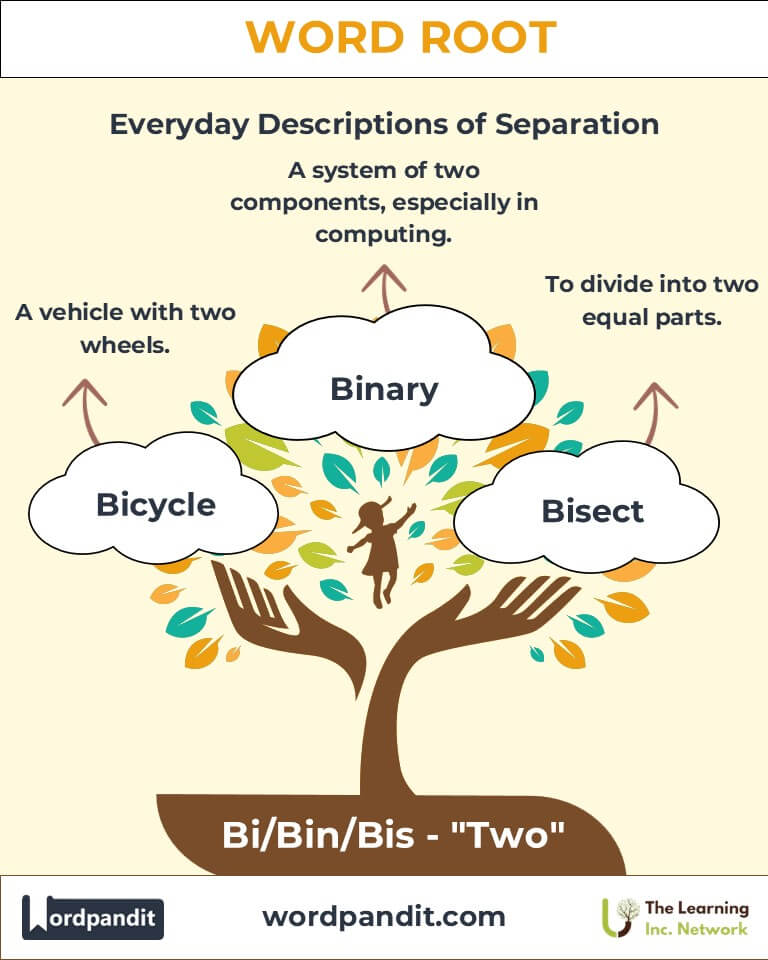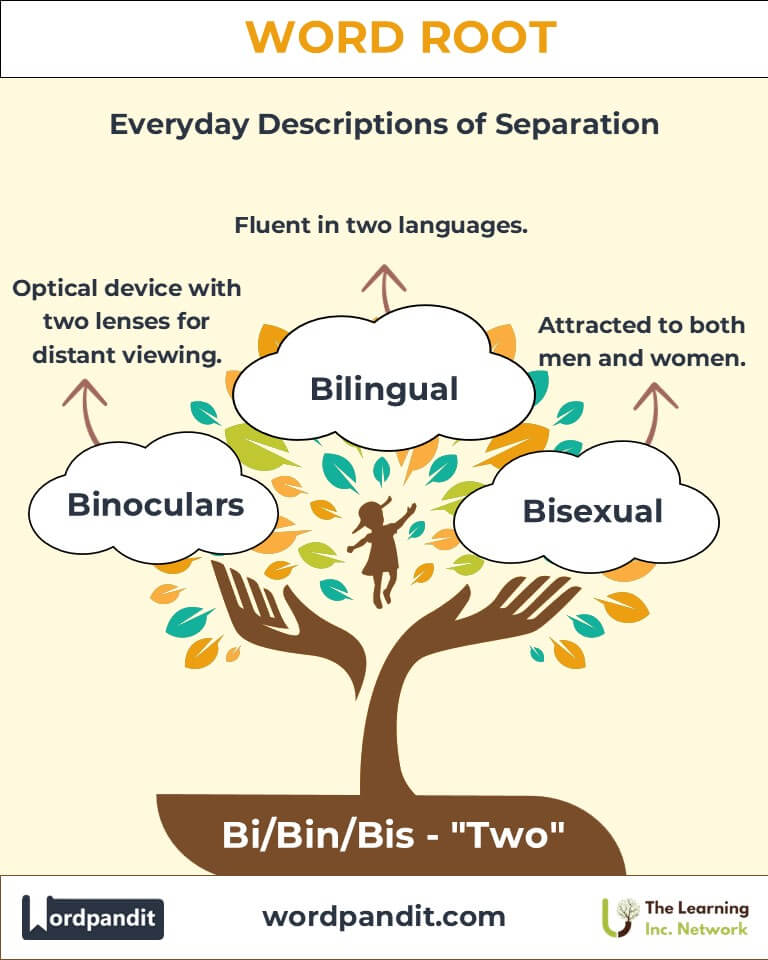Bi/Bin/Bis: The Root of Twofold Meanings Across Language and Science
Byline:
Discover the versatility of the word root "Bi/Bin/Bis," originating from Latin, meaning "two" or "double." From words like "binary" in technology to "bisect" in geometry, this root has laid the foundation for terms that explore duality, pairs, and division in various disciplines.

Table of Contents
- Introduction: The Essence of Bi/Bin/Bis
- Etymology and Historical Journey
- Mnemonic: Unlocking the Power of Bi/Bin/Bis
- Common Bi/Bin/Bis-Related Terms
- Bi/Bin/Bis Through Time
- Bi/Bin/Bis in Specialized Fields
- Illustrative Story: Bi/Bin/Bis in Action
- Cultural Significance of Bi/Bin/Bis
- The Bi/Bin/Bis Family Tree
- FAQs about the Bi/Bin/Bis Word Root
- Test Your Knowledge: Bi/Bin/Bis Mastery Quiz
- Conclusion: The Living Legacy of Bi/Bin/Bis
Introduction: The Essence of Bi/Bin/Bis
What do bicycles, bilingual conversations, and binary codes have in common? They all reflect the influence of "Bi/Bin/Bis," a Latin root meaning "two" or "double." This root is pivotal in terms that explore pairs, duality, and division across various fields, including science, technology, and language.

Etymology and Historical Journey
The root "Bi/Bin/Bis" derives from the Latin prefix bi- (two) and its variant forms bin- (two by two) and bis- (twice). It entered English during the Middle Ages through Latin and Old French, gaining prominence in disciplines that value precision, such as mathematics and linguistics.
Mnemonic: Unlocking the Power of Bi/Bin/Bis
Mnemonic:
“Bi brings pairs to life: two wheels, two lenses, and double meaning!”
Picture a bicycle, its two wheels symbolizing balance and motion. Or imagine a pair of binoculars offering twofold vision. These vivid images anchor the root’s meaning in your memory.
Common Bi/Bin/Bis-Related Terms
- Binary (bye-nair-ee): Pertaining to two parts or a system of two.
Example: "Binary code is the foundation of digital computing." - Bisect (bye-sekt): To divide into two equal parts.
Example: "The artist bisected the canvas to create a symmetrical design." - Bicycle (bye-si-kuhl): A vehicle with two wheels.
Example: "She rode her bicycle along the scenic trail." - Bilingual (bye-ling-gwuhl): Fluent in two languages.
Example: "Being bilingual opens doors to more career opportunities." - Binoculars (bi-nok-yuh-lurz): An optical device with two lenses for viewing distant objects.
Example: "The birdwatcher used binoculars to observe the rare eagle."
Bi/Bin/Bis Through Time
- Bisexual: A term initially used in botany to describe plants with both sexes, later adopted to denote sexual orientation.
- Binary: Evolved into the basis of computer logic and digital systems.
Bi/Bin/Bis in Specialized Fields
- Technology: Binary forms the language of computers, encoding information in pairs of 0s and 1s.
- Biology: Binomial nomenclature (two-part names) classifies organisms systematically.
- Mathematics: The bisection method is used in numerical analysis to find roots of equations.
Illustrative Story: Bi/Bin/Bis in Action
Lila, a bilingual coder, worked on a binary algorithm to improve language translation apps. Using her binoculars during a break, she watched migrating birds that, like her project, embodied harmony in duality. Her story highlights how "Bi/Bin/Bis" bridges nature, technology, and human communication.
Cultural Significance of Bi/Bin/Bis
"Bi/Bin/Bis" reflects the human fascination with pairs and duality, from yin-yang philosophy to twin studies in psychology. This root underscores the significance of balance and symmetry in cultural narratives and scientific discoveries.

The Bi/Bin/Bis Family Tree
- Di- (Greek, Two): Examples: Dichotomy, diplomat.
- Semi- (Latin, Half): Examples: Semicircle, semiannual.

FAQs About the Bi/Bin/Bis Word Root
Q: What does the root "Bi/Bin/Bis" mean?
A: The root "Bi/Bin/Bis" means "two," "double," or "twice." It originates from Latin and is commonly used to signify duality or something that involves two parts, as seen in words like "bicycle" (two wheels) or "binary" (a system of two).
Q: Why are there different forms of the root, such as "Bi," "Bin," and "Bis"?
A: The variations arise from linguistic evolution and grammatical usage. "Bi-" is the most common prefix, used to mean "two" or "double," as in "bilingual." "Bin-" is used before vowels or certain consonants for ease of pronunciation, as in "binary." "Bis-" often means "twice" or "twofold" and appears in words like "bisect."
Q: What is the difference between "bisect" and "divide"?
A: "Bisect" specifically refers to splitting something into two equal parts, emphasizing symmetry and balance. "Divide," on the other hand, is a broader term that means splitting something into any number of parts, which may not be equal.
Q: How does "binary" relate to technology?
A: "Binary" is foundational to computer science, representing data using two states: 0 and 1. This two-part system is simple yet powerful, forming the basis of all digital technology, from coding to data storage.
Q: What is "binocular vision"?
A: "Binocular vision" refers to the ability of animals, including humans, to see with two eyes that provide slightly different perspectives. This overlapping vision helps in depth perception, allowing us to judge distances accurately.
Q: How is "bisexual" used in different contexts?
A: Originally a botanical term for plants with both male and female reproductive organs, "bisexual" now primarily refers to a person who is romantically or sexually attracted to both men and women, emphasizing its connection to duality.
Q: What is "bilingualism," and why is it important?
A: Bilingualism is the ability to speak and understand two languages fluently. It enhances cognitive flexibility, improves communication in multicultural settings, and often leads to better job opportunities.
Q: Can "bi-" mean something other than "two"?
A: No, "bi-" specifically means "two" or "double." However, some words like "biannual" can be ambiguous, as it may mean "twice a year" or "every two years." Context usually clarifies the intended meaning.
Q: Why is "bi-" not used exclusively for all two-related terms?
A: English borrows from multiple languages, including Greek. Terms like "dichotomy" or "dilemma" use the Greek root "di-" for "two," while "bi-" comes from Latin. The choice depends on the word's etymological origin.
Q: How does "bisect" relate to geometry?
A: In geometry, "bisect" is a precise action where a line, angle, or shape is divided into two equal parts. For example, a perpendicular bisector divides a line segment into two equal halves at a 90-degree angle.
Test Your Knowledge: Bi/Bin/Bis Mastery Quiz
1. What does the root "Bi/Bin/Bis" signify?
2. Which term uses "Bi" to describe a system of two components?
3. What does "Bisect" mean?
4. Which term is foundational to computing?
Conclusion: The Living Legacy of Bi/Bin/Bis
From ancient linguistic roots to modern applications, "Bi/Bin/Bis" continues to shape our understanding of duality and balance. Its legacy spans language, technology, and culture, underscoring humanity's appreciation for pairs and symmetry.












